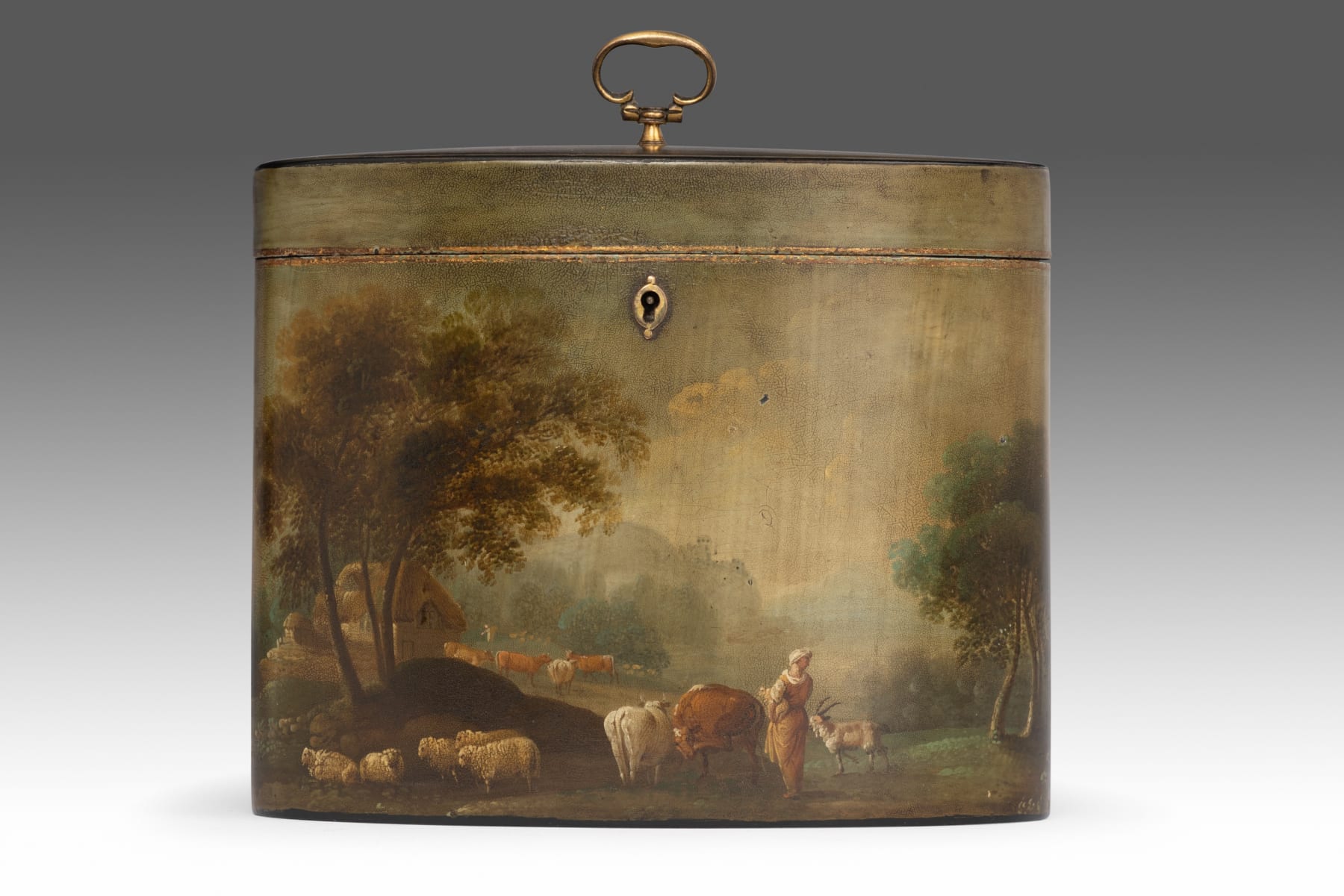George III Painted Papier-mâché Tea Caddy attributed to Henry Clay (c.1740 – 1812)
ENGLAND, CIRCA 1780
papier-mâché, tin, brass, paint
12 x 14.5 x 8 cm
4 ¾ x 5 ¾ x 3 ¼ in
4 ¾ x 5 ¾ x 3 ¼ in
7166
Further images
Provenance
Ex McGreery Collection
Of oval form with a brass hinge and gilt brass loop c-scroll handle to the lid, key escutcheon to the front with key, painted overall with pastoral scene depicting figures,...
Of oval form with a brass hinge and gilt brass loop c-scroll handle to the lid, key escutcheon to the front with key, painted overall with pastoral scene depicting figures, cattle and sheep, a cottage, a distant mansion house and river landscapes. The tin-lined interior with a lacquered lift-off lid with a small gilt brass loop c-scroll handle, the inner borders with dot decoration.
Henry Clay (c. 1740-d. 1812) was a British artisan known for his work with papier-mâché. His caddies, manufactured in Birmingham, were renowned for their intricate decorations, often featuring rural scenes, classical motifs, or chinoiserie designs. In 1772 Clay patented a form of papier-mâché which could be carved, cut and lacquered with the strength of wood but did not warp and was lighter in weight. It specified ‘Making, in Paper, High Varnished Pannels [sic) or Roofs for Coaches, and all Sorts of Wheel Carriages, and Sedan Chairs, Pannels [sic) for Rooms, Doors, and Cabbins [sic] of Ships, Cabinets, Bookcases, Screens, Chimney Pieces, Tables, Teatrays, and Waiters.’ … ‘pasting several papers upon boards... [which are] put in a stove sufficiently hot to deprive them of their flexibility, and at the same time are rubbed over or dipped in oil or varnish, which so immediately drenches into them as to secure them from damps... they are capable of being sawed into different forms, and planed as wood.... then coated with colour and oils sufficient to make the surface even, and then japanned and high varnished.’ The patent lasted until 1802. Around 1785 Henry Clay acquired shop premises in Covent Garden. George III was one of his patrons by 1792 and Clay adopted the title 'Japanner in Ordinary to His Majesty and His Royal Highness the Prince of Wales'.
See Stevens and Jones, ‘Chapter 16 Papier-mâché’ in The Story of British Tea Chests and Caddies, for comparators. They note that by the 1770s oval caddies were the most fashionable and the form was created by wrapping sheets of pasted paper around a wooden oval form mould. (p. 287-291).
A comparable tea caddy attributed to Clay sold at Woolley and Wallis, The Nolte Collection, 25 September, 2007, lot 158 for £6,000.
Henry Clay (c. 1740-d. 1812) was a British artisan known for his work with papier-mâché. His caddies, manufactured in Birmingham, were renowned for their intricate decorations, often featuring rural scenes, classical motifs, or chinoiserie designs. In 1772 Clay patented a form of papier-mâché which could be carved, cut and lacquered with the strength of wood but did not warp and was lighter in weight. It specified ‘Making, in Paper, High Varnished Pannels [sic) or Roofs for Coaches, and all Sorts of Wheel Carriages, and Sedan Chairs, Pannels [sic) for Rooms, Doors, and Cabbins [sic] of Ships, Cabinets, Bookcases, Screens, Chimney Pieces, Tables, Teatrays, and Waiters.’ … ‘pasting several papers upon boards... [which are] put in a stove sufficiently hot to deprive them of their flexibility, and at the same time are rubbed over or dipped in oil or varnish, which so immediately drenches into them as to secure them from damps... they are capable of being sawed into different forms, and planed as wood.... then coated with colour and oils sufficient to make the surface even, and then japanned and high varnished.’ The patent lasted until 1802. Around 1785 Henry Clay acquired shop premises in Covent Garden. George III was one of his patrons by 1792 and Clay adopted the title 'Japanner in Ordinary to His Majesty and His Royal Highness the Prince of Wales'.
See Stevens and Jones, ‘Chapter 16 Papier-mâché’ in The Story of British Tea Chests and Caddies, for comparators. They note that by the 1770s oval caddies were the most fashionable and the form was created by wrapping sheets of pasted paper around a wooden oval form mould. (p. 287-291).
A comparable tea caddy attributed to Clay sold at Woolley and Wallis, The Nolte Collection, 25 September, 2007, lot 158 for £6,000.
1
of
59














